Nepal is a country vibrant with colors, traditions, and clothes to match. A country that is extremely diverse with well over 100 ethnic casts living in it, has a unique history and relationship with different traditional dresses. With each caste having a different version, or outfit all together, it is difficult to pinpoint what the Nepali traditional dress would be. Not only does heritage and culture play a role in the different outfits in the country, but also the differences in climate and weather play an important role in how the traditional wear of each region evolved.
From the high elevations of the Himalayas to the lowlands of the Terai, Nepalis have developed unique and at times, flamboyant dresses to represent their cultures and heritages. In this article, I will present the different traditional Nepali dresses that can be found throughout the country.
Without further ado, let’s begin our Nepali traditional dress fashion show! We will start by first discussing and talking about a question that gets commonly misunderstood and answered: What is the National dress of Nepal?
What is the National dress of Nepal?
There has been no national dress in Nepal since 2011. Historically, the Daura Suruwal for males and Gunyo Cholo for females were the national dresses of Nepal. However, around 2008 the then Prime Minister, Baburam Bhattarai, began removing the two from being the national dress, and they were officially removed after Nepal became a federal republic in 2011.
The idea of having a national dress in Nepal, and more specifically having the Daura Suruwal and Gunyo Cholo as the national outfit, was introduced and engrained in the Nepalese people in the early and middle part of the nineteenth century by the then Prime Minister, Bir Shamsher Rana in the hopes to insight nationalism and bring the country together. He encouraged the people in Nepal at that time to wear dress to all formal events.
As for the reason behind removing the Nepali national dress, many people believe that it wasn’t representative of the country. Whereas, with over 100 ethnic castes in Nepal, only a select few of them could directly associate themselves with the Daura Suruwal. A good example of the Daura Suruwal and Gunyo Cholo not representing the diversity of the country well is with the Madhesi and Tharu communities in the terai (especially around the Lumbini and Chitwan area), as well as various other Janjati communities living throughout the country.
With all that being said, the Durwal Suruwal did evolve into and is accepted by many as being the go-to formal wear, for many festivals and celebrations in Nepal. We should note that many Magars and Gurungs enjoy wearing the traditional Nepali Dhaka fabric as well!
Nepalese Traditional Clothing:
Below are five different castes of Nepal and their different traditional clothing styles. Each of the Nepalese traditional clothing styles are unique and rooted in the traditions and cultures that the particular caste celebrates.
1. Gurung and Magar Traditional Dress
The first traditional Nepali dress we will discuss belongs to the Gurungs. The Gurungs are traditionally people who reside in the central mountain region of Nepal, especially in the Syangja and Lamjung areas. Although the origins of the Gurung people are uncertain, they are of Mongolian descent and are believed to have migrated from Tibet around 2,000 years ago.
Gurungs still wear their traditional clothing for festivals in Nepal, religious events, and various celebrations. However, much of the younger generations have begun wearing more western style clothing to such events. The traditional wear of the Gurungs is explained below:
Gurung & Magar Women Traditional Dress:
The traditional wear of Gurung women is characterized by their blouse or cholo, which is sometimes shorter showing off their mid section. The blouse can be a variety of colors, but typically is black and on occasion red, which is adorned with various designs and patterns on it. The blouse ties together in the back with two long string-like tassels.
In addition to the blouse, the women wear a long pleat-like skirt called a phariyā or lungi and is usually dark in color (typically black or blue). Over the two main parts of the outfit, women also wear what is called a ghalek. A ghalek is a piece of cloth that hangs from one shoulder and runs across the body to the opposite waist. Moreover, the ghalek wraps around the entire body and then is tied around the shoulder. It is tied in such a fashion that it creates a bag-like structure and allows the women to carry things in it.
Finally, the women are also typically adorned with a great deal of silver, gold, and other ornaments. For example, the women typically wear large, heavy silver or gold earrings, nose rings, as well as square amulets that hang from a necklace of glass beads, called vase necklaces. Additionally, traditionally, the women would also wear various bracelets or Chura, and anklets.
The Magar dress is similar to the Gurung style dress with a few different features. Magars still wear their traditional dress for auspicious occasions, and especially for Magh Sankranti, which is one of the most important Magar festivals of the year. The Magar women wear a Phariya or a sort of Lungi and a Choubandi Cholo which is a uniquely designed closed blouse often made of velvet material and a heavily tied waistband known as the Patuki. They wear a Mujetro or a shawl-like cloth that is tied on the shoulders and uniquely covers the body. Many traditional ornaments are decorated on different parts of the body making a show of grandly decorated outfits.
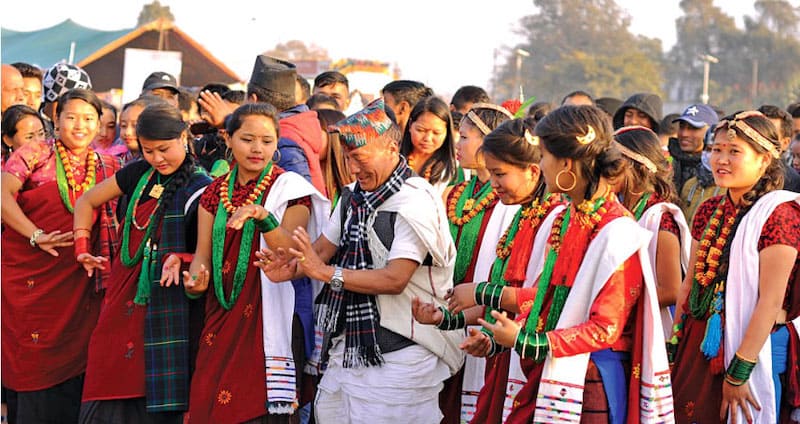
Gurung Men Traditional Dress:
In terms of their clothing, the traditional Gurung dress for men consists of two main components. The first is a blouse or bhoto that uses multiple laces to tie together on the front of the body with one lacing point towards the side of the chest and the next on towards the bottom portion of the stomach. The next component of the dress is the bottom portion and is a piece of fabric that is in the shape of a skirt which is called a Jama. The Jama wraps around the waist and runs down to the center of the thigh or right above the knee.
Additionally, the traditional Gurung dress of Nepal has a long piece of cloth that is tied around the waist of the man like a belt and allows for a Khukhri to be slid into the cloth and held. Gurung Men typically wear bhangra as well, which is outerwear which is wrapped around the chest of the man in the shape of an ‘x’. The Bhangra covers the entire back portion of the man, and is typically white in color, with thin red or blue lines of color. The Bhangra is also in the shape of a bag in the back allowing for the men to carry things. Finally, the man’s outfit is topped off with a Nepali topi (hat) to complete the dress.
Just like the Gurung men, the Magars wear a Kachhad or a wraparound loincloth that reaches a centimeter above the knees, and a Bhoto, which is a cloth that is uniquely tied around the chest of the men along with a Nepali Topi.
2. Newari Traditional Dress:
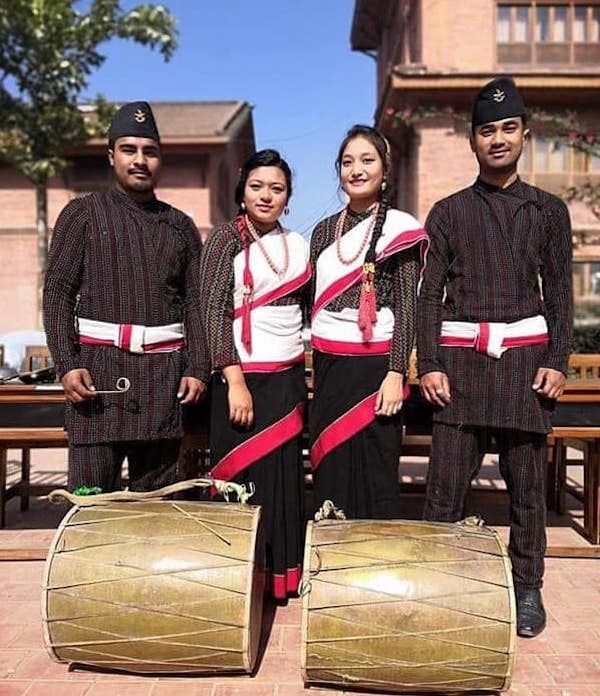
The Newari people have a very distinct and strong culture. Well known for their food and drinks, Newaris also have a distinct traditional dress that they enjoy wearing for auspicious days and festivals. Even though, Newaris are well known for being indigenous people of the Kathmandu Valley, they live throughout the country and have historically been trades and business people. That being said, most of the Newars throughout the country share a very close identity, and relationship, which is reflected in their traditional fashion.
The garments of the Newars are associated with the old aristocracy, merchants, farmers, craftsmen and professionals. Weaving used to be a major industry in Kathmandu and clothes were made at home. People also wove clothes to sell. The finished product was then sent to be dyed to the dyers who made up a caste group called Chhipa (now Ranjit or Ranjitkar). Italian Jesuit, Ippolito Desideri had written a description of the clothes worn by Newars (in the 18th century) in his travelogue. He mentioned that the Newars wore a woolen or cotton jacket that reached to their knees and trousers to their ankles with a red cap and slippers. In 1973, the government of Nepal also issued a postage stamp series of the traditional clothes worn in different parts of the country.
Tapālan:

The Newar men wear a long shirt called tapālan and fitting trousers knows as suruwā. The outfit is accompanied by a waistcoat and a coat. Today, the outfit is worn on special occasions and festivals, however, it is still a daily outfit for the older generation. Men wear tapālan and women wear hāku patāsi in special festivals and family occasions.
Hāku Patāsi:
During the festive season in the country, if you’ve visited Newari cities, you might have noticed women in black cotton saris with a red border. It is known as hāku patāsi or hāku parsi. It is the most common dress worn during festive occasions and still widely worn by the older generation or women farmers as everyday wear. A blouse which is called the misālan is worn with the sati and accompanied by a shawl, gā (gaa) is wrapped around the upper part of the body.
Sayn Kaytā:
Sayn kaytā are traditional men’s trousers. The baggy trousers were worn mostly by the merchant and courtier classes till the 1930s. The trousers used a drawstring to be tied around the waist. Raw silk material was used to make the sayn kayta. The sayn kayta is worn with a long shirt and cotton cummerbund to complete the set.
Parsi:
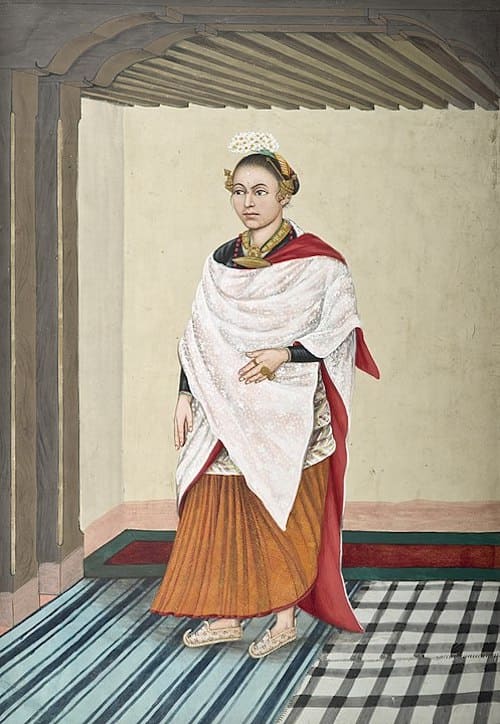
Some classes of Newar women wore plain or printed saris as parsi. Just like any normal sari, it has many pleats which are gathered at the front and tied in a bunch with a piece of string. These saris were up to 20 yards long.
3. Sherpa Traditional Dress
Another distinct traditional Nepali dress belongs to the Sherpas. Now, of course, many people have heard of Sherpas in Nepal. However, there is a fine distinction between the caste and the sherpas that are porters in the upper Himalayas. The Sherpa caste is a culturally rich and distinct community that has lived in the upper reaches of the Himalayas for generations. Living at such high altitudes has historically meant isolation from many of the other customs and traditions in Nepal. Furthermore, this isolation has resulted in the Sherpa traditional dress evolving into a very unique set of Nepali clothes!
Sherpa Women Traditional Dress:
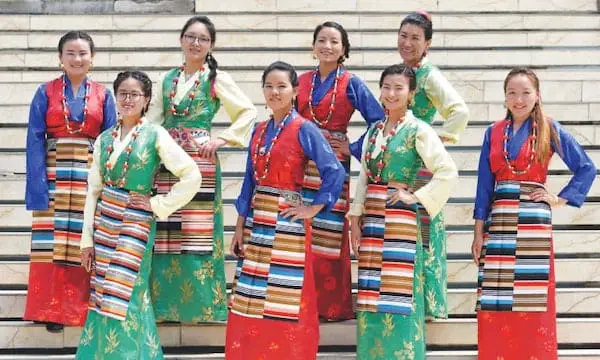
The traditional dress for women heavily resembles Tibetan clothing and traditionally used wool and silk spun at home. However, now many of the dresses are being replaced by factory-made materials that are ready-made and quick to buy.
The actual dress consists of dresses that are long-sleeved and usually reach the floor. These dresses are made from thick wool and are called tongkok. In addition to the tongkok, there is a more warm weather version of the traditional wear that has short sleeves. The shortsleeve version is called an angi and is worn over a blouse which is called a raatuk.
Over the top of these long- and short-sleeved costumes, Sherpa women wear colorful striped aprons, one in the front ‘metil’ and one in the back ‘gewe’. These two aprons are then held together by a very distinctive embossed silver buckle called a kyetig.
The dress of the women and men do share some common features. One such clothing feature is the unique high, woolen boots that both women and men wear. In terms of design, the upper portion of the boots is colored maroon, red, and green, or blue. The boots also have colorful garters on them which are used to tie the boots.
Sherpa Men Traditional Dress:

Sherpa men also wear robes that have long sleeves and that stretch all the way below the knees. These robes are called a kitycow and are exceptional at protecting the men from the frigid weather at high elevations. In addition to the kitycow, the men also wear a chhuba which is tied around their waist, and a cloth sash that is called a kara. These two clothing features create an additional pouch, or tolung, which allows the man to carry small items on his person.
In addition to the boots that both the men and women wear (mentioned in the Sherpa women’s traditional wear above) both men and women also wear long inner-shirts to protect them from the cold. The inner shirts – wan-ju for women and wan-tash for men – are traditionally made out of wool that was spun at home. Finally, over the wan-ju and wan-tash, the men and women also wear a thick wraparound robe known as a Bahku.
4. Tharu Traditional Dress
The final Nepali traditional dress we will discuss is from the Tharu caste. Even though Tharus make up 5% of the entire Nepali population, they are still a relatively misunderstood community from the terai in Nepal. With unique eating habits, and their own language and culture, the Tharu community has a strong and rich heritage. And the Tharu traditional dress is no different, as it has evolved into a strong representation of the community’s culture. With the majority of the community historically living in the flat lands of Nepal, one of the hottest places in the country, the Tharu dress has evolved to represent these defining characteristics.
Tharu Women Traditional Dress:
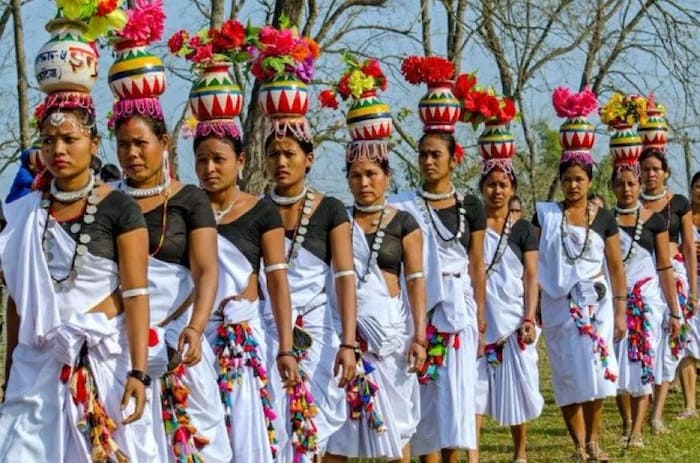
The women have a very unique traditional dress that has been shaped by the climate they live in. They were what is called a cholia (choli) as a top that is like a crop top blouse and is typically black in color. Next, they wear a white cloth dress called a Nahagi and a Uporona which is a piece of cloth that is worn around the chest area of the women.
In addition to the attire that is worn, another major component of the Tharu dress is the various ornaments that are worn. A few examples of the ornaments and jewelry that the the women wear are: “Nathiya” on the nose, “Kanphul” in the ear, “Hansuli” and “Kanthi” on the neck, “Matha” on the wrist, “Tadia” on the elbow,”Tikuli” on the forehead and “Upairi” on their feet.
Tharu Men Traditional Dress:
A distinct article of clothing for Tharu men is the mardani, or dhoti that they wear. A dhoti is a thin piece of fabric that is wrapped around the waist of the men and runs down to below their knees. This type of clothing shows just how hot it is in the regions where Tharu people live, as it is extremely difficult to wear any type of pants because of the heat.
Although the dress for Tharu men is relatively simple as described above, another unique article that they wear is a large hat made from bamboo and dried leaves. The hats once again are made and worn to help protect the individual from the intense sun and heat that is typical of the Terai region.
Nepali Traditional Dresses and Outfits:
The International Mountain Museum in Pokhara has a great collection of traditional outfits and dresses from all around Nepal. Below are photos from a few of the displays they have at the museum.
Nepali Traditional Dress FAQs
Below are some of the most frequently asked questions regarding traditional Nepali dress.
The traditional dress in Nepal for women is the sari, for men, it is the Durwal Suruwal. Nepalese usually wear these traditional dresses to official events, wedding ceremonies, or cultural festivals.
The Nepali traditional dress for girls is the sari, worn for decades and similar to those worn by Indian women. It consists of a petticoat, blouse, and draped sari over the shoulder, often adorned with gold jewelry and ornaments.
Nepal is a diverse country with various ethnic groups, and each group has its own unique traditional dress. Therefore, there are many traditional dresses, and it’s difficult to give an exact number. Some popular Nepalese traditional clothing options are Sari, Kurtha Suruwal, Dhaka Topi, Gunyu Cholo, and Newari Dress, among others.
In Nepal, boys and men wear Durwal (double-breasted shirt) and Suruwal (trousers), with additional pieces like a vest or jacket and headdress. The informal traditional outfit combines a Durwal Suruwal with a jacket. This outfit was updated by Prime Minister Jang Bahadur Rana. The ensemble represents the main elements of Nepalese attire.
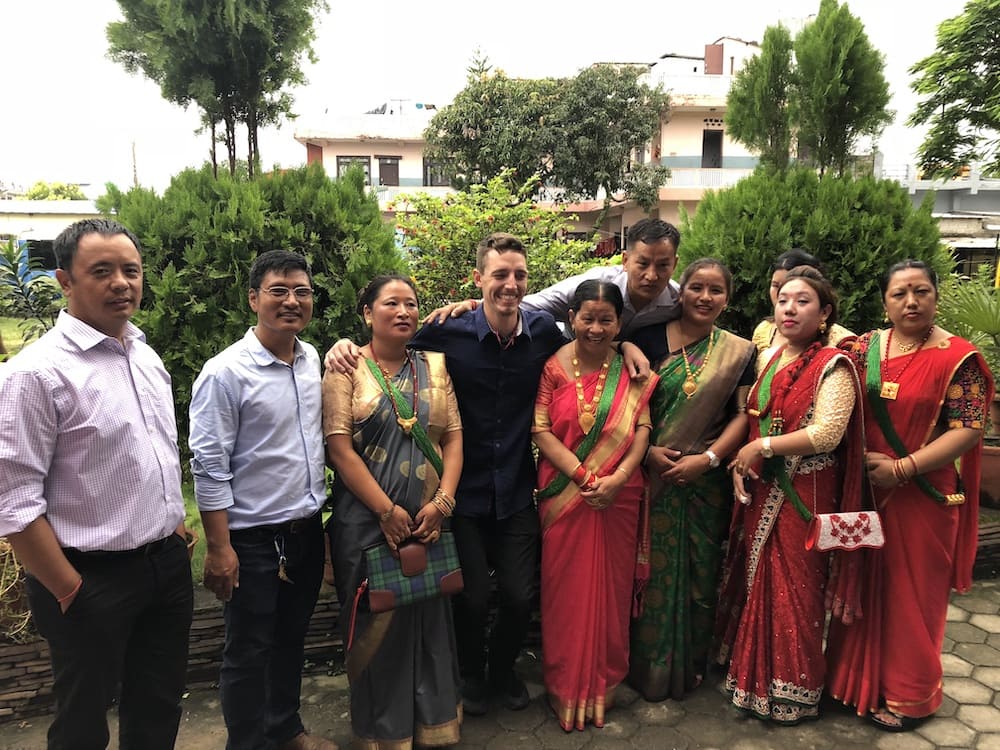

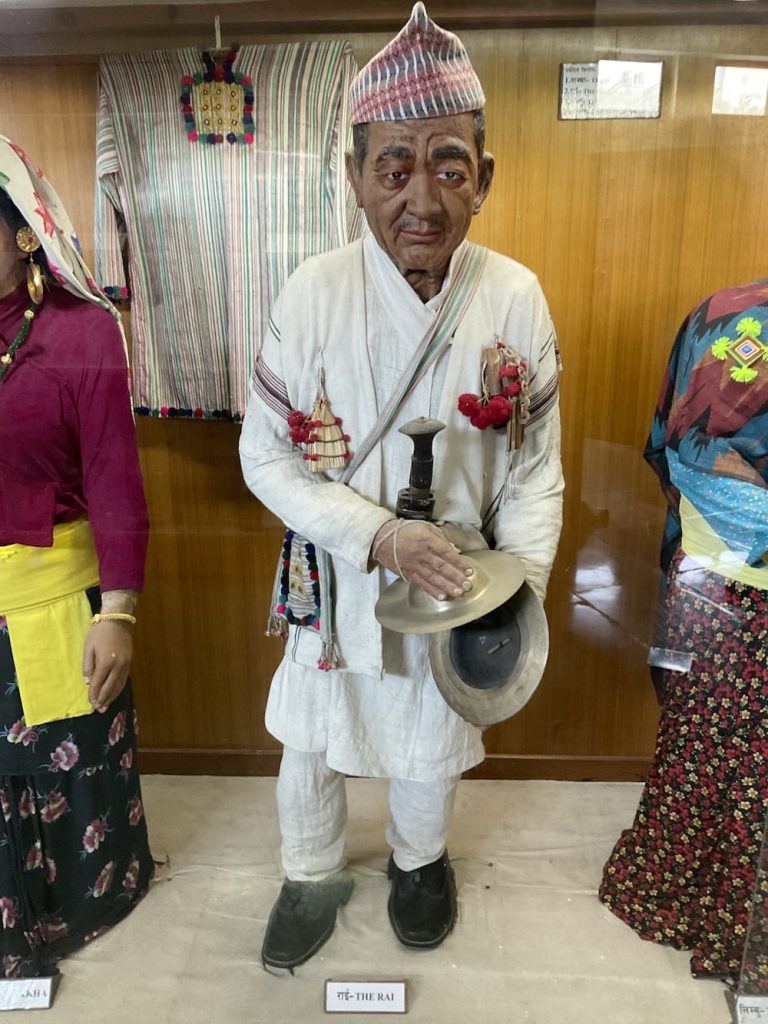
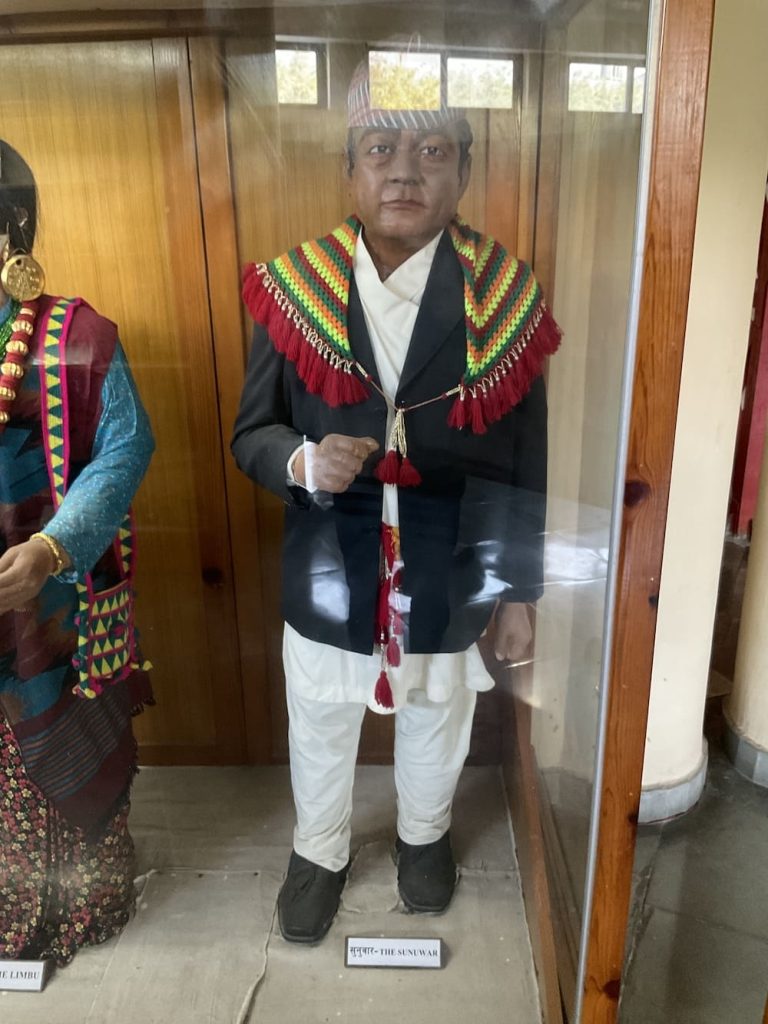
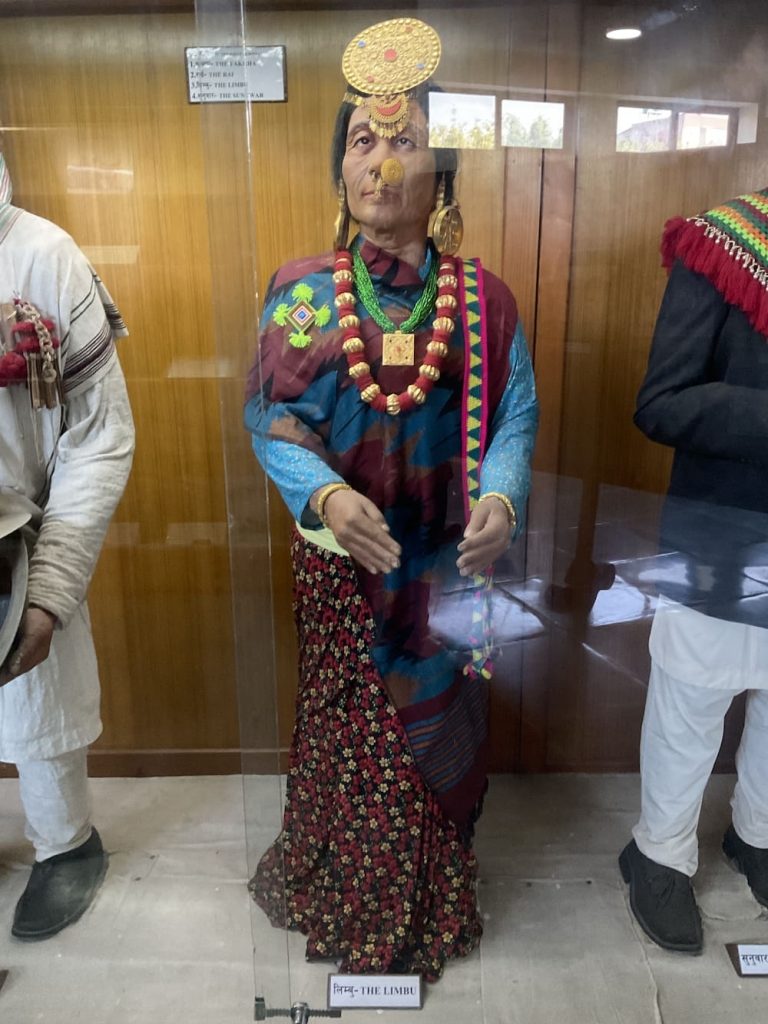

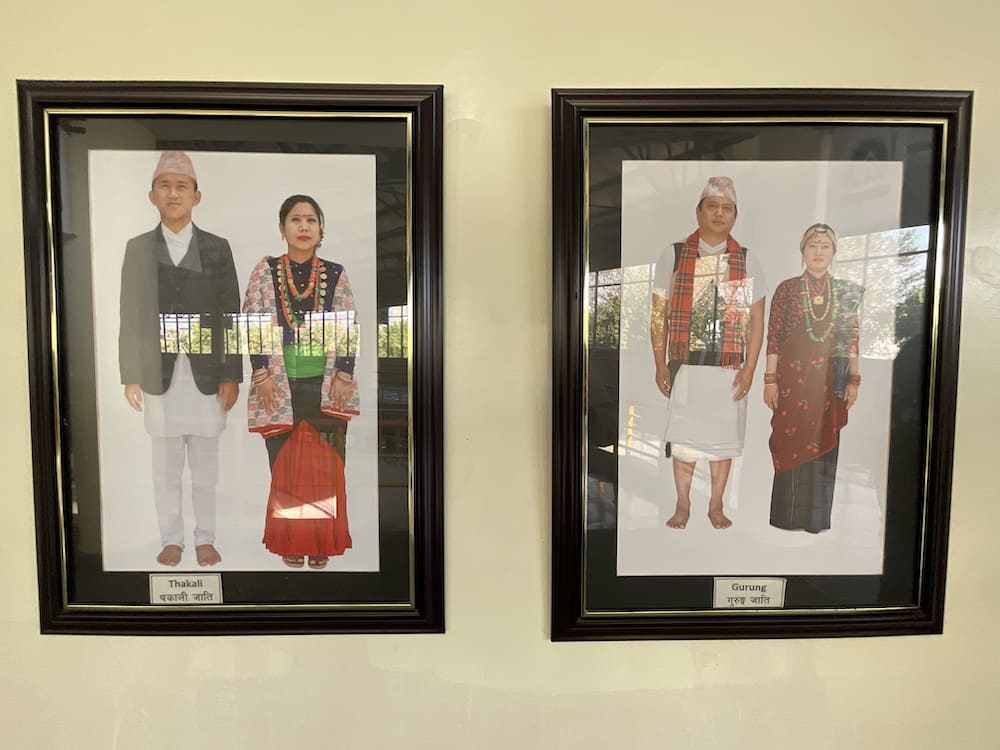
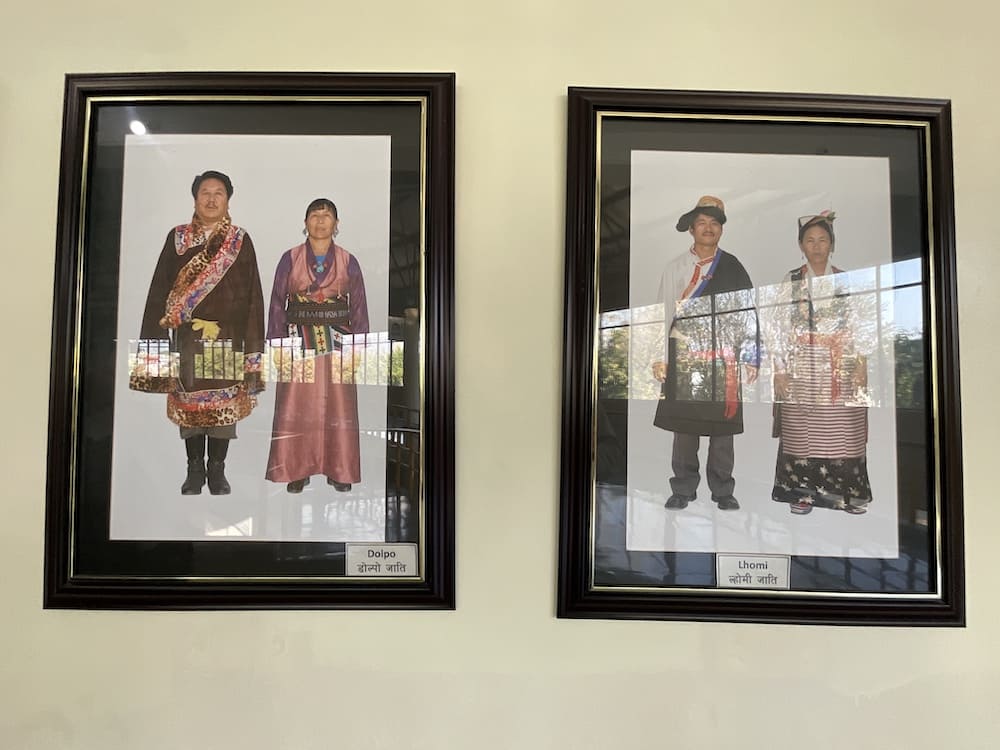

Dear vai Hayden Rue
I am happy that i found your nepali dhaka cloth blog. So i like to read more about nepali cloth and Dhaka fabric
Thank you Ram Dai! I am happy you were able to find it. You were the one that taught me everything about Dhaka Fabric in Nepal in the first place! Hope you are well!